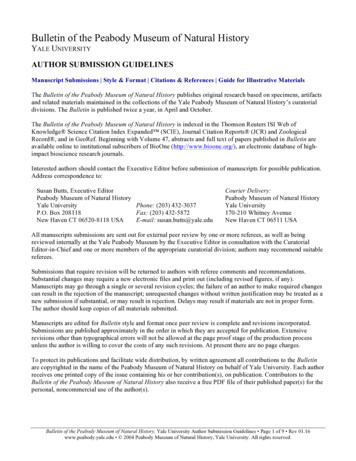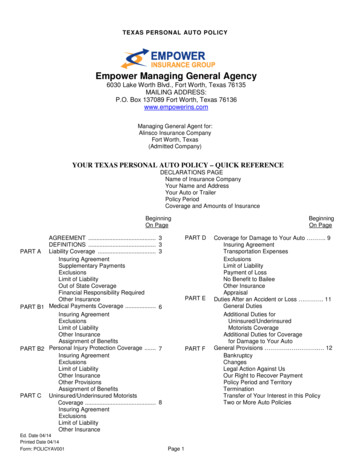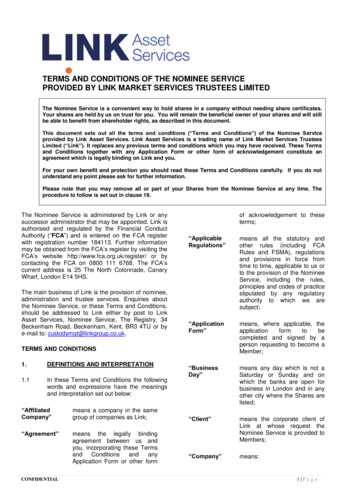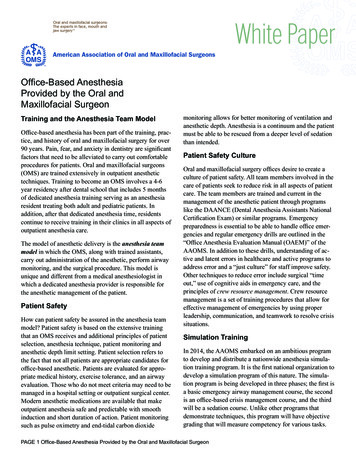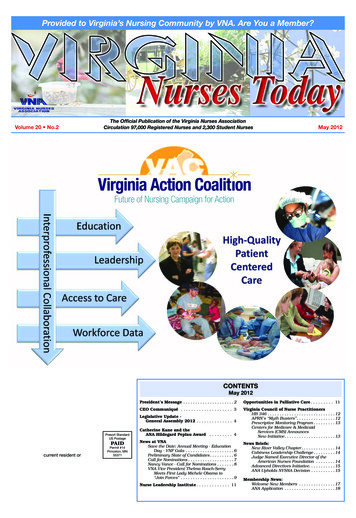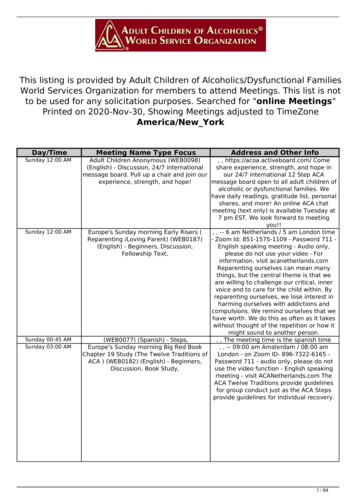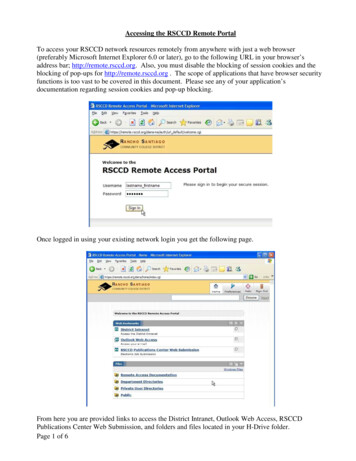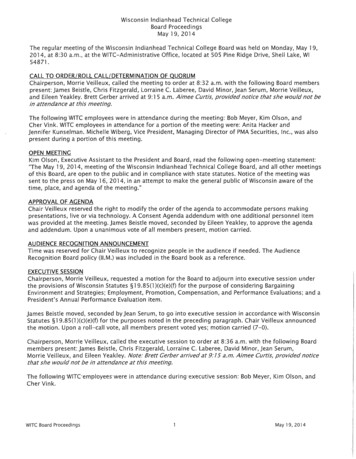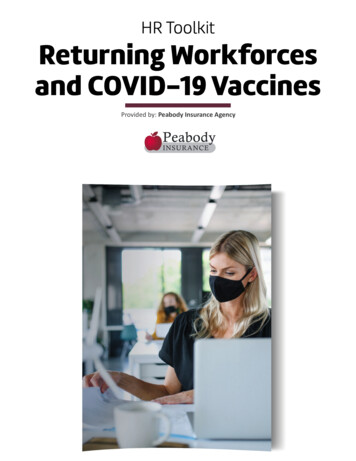
Transcription
Provided by: Peabody Insurance Agency
Table of ContentsTable of Contents .2Introduc on .5Return-to-Work at a Glance .6COVID-19 Return-to-Work Plans .6Other Return-to-Work Considera ons .8COVID-19 Vaccine Overview .9COVID-19 Vaccines and the Workplace .12Government Guidance Related to COVID-19 Vaccines and Workplaces .12OSHA Perspec ve .12EEOC Perspec ve .12Deciding Between a Mandatory or Voluntary Vaccina on Policy .14General Employer Considera ons .14The Case for Mandatory Workplace Vaccina on .15The Case for Voluntary Workplace Vaccina on .15Developing a Workplace Vaccina on Plan .17Step 1: Gauge the Situa on .17Step 2: Make the Choice.17Step 3: Consider Incen ves .17Step 4: Ensure Resources Are in Place .17Step 5: Communicate Everything to Employees .17Step 6: Implement the Plan .17COVID-19 Vaccines and Workplace Laws .18Medical Examina ons and Vaccine Administra on .18Prescreening Vaccina on Ques ons .18COVID-19 Vaccina on Veri ca on and Disability-related Inquiries20Emergency Use Authoriza on (EUA) and the COVID-19 Vaccine .20Employees with Disabili es Preven ng Vaccina on iSincere Religious Beliefs Preven ng Vaccina on.222
No Reasonable Accommoda on Available .22Gene c Informa on, Employment Decision-making and Vaccina ons22Appendix .24Mandatory COVID-19 Vaccina on Policy .26Voluntary COVID-19 Vaccina on Policy .28Mandatory COVID-19 Vaccina on Le er to Employees .29Voluntary COVID-19 Vaccina on Le er to Employees .30COVID-19 Vaccina on Employee Le er for Essen al Workers .31Employer Will Cover the Cost of COVID-19 Tes ng Le er .32Welcome Back to Work - Employee Communica ons Le er .33COVID-19 Symptom Screening Checklist .36COVID-19 Vaccine Workplace Planning Checklist .39Responding to a Posi ve COVID-19 Test Checklist .44Return-to-Work Communica ons Planning Checklist .48Workplace Reopening Decision Infographic .51COVID-19 Vaccina on: What to Expect Handout .52Iden fying Misinforma on About COVID-19 Vaccines - Infographic .54Three Ways to Avoid COVID-19 Vaccine Scams .55Building Con dence in COVID-19 Vaccines - Infographic .56What You Need to Know About the COVID-19 Vaccines - Infographic .57COVID-19 Vaccine Myths - Infographic.58Con nuing the Journey of a COVID-19 Vaccine - Poster .59How to Wear a Face Covering Poster i3
tiThis HR Toolkit is not intended to be exhaus ve nor should any discussion or opinions be construed as legal advice. Readers should contact legal counsel for legal advice. 2021 Zywave, Inc.All rights reserved.
Introduc onThe COVID-19 pandemic has been raging for months. In that me, many businesses have ceasedopera ons out of safety concerns and have waited for the right opportunity to resume. Now, withCOVID-19 vaccines becoming available, employers can nally start planning for their immediate futures.There are s ll many unknowns related to the COVID-19 vaccines, but there is at least one agreed-uponfactor: Vaccina ng employees is the best way to reopen a business safely. However, while it may be thebest tool in the arsenal, it is not the only one. Employers will s ll need to con nue using safeguards suchas masks and social distancing to ensure the safety of their workers and customers.With that in mind, this toolkit explores the COVID-19 vaccines and other workplace safeguards, andhelps employers decide whether a vaccina on policy is right for their organiza ons. Included at the endis a robust appendix with printable resources that employers can use right now, including policies,communica ons and more.As always, Peabody Insurance Agency will be here to answer any ques ons related to this toolkit andother workplace ma ers.tititititifitititttitititi5
Return-to-Work at a GlanceThere are many bene ts of return-to-work plans for bothemployers and employees. Employers can enjoy increasedemployee engagement, proac ve cost containment,reduced turnover, increased communica on and improvedmorale with an established return-to-work plan. And it’sbeen proven that employees who go through return-towork plans are able to get back to work quicker than thosewho don’t, meaning that employers will see increasedproduc vity following an employee’s return to work.Employees also bene t from return-to-work plans, as they feel supported by their employer, whichincreases their engagement and loyalty to the company. U lizing a return-to-work plan also helps themget back to work faster and increases the likelihood that they feel secure and stable in their role.The bene ts of return-to-work plans are undeniable. While these plans are typically customized on anindividual basis, employers can use the basics of a return-to-work plan to build their company’smethodology for ge ng employees to return to work following the COVID-19 pandemic.COVID-19 Return-to-Work PlansCOVID-19 has caused many businesses to shut down or transi on their employees to work from home,disrup ng daily work life for many. As stay-at-home regula ons are scaled back and all businesses areallowed to resume as normal, employees will be asked to come back to work. While they may not becoming back from an injury or leave, employers s ll need to have a plan in place for all employees tosafely and successfully return to work. This will be true even a er employees are vaccinated againstCOVID-19, as return-to-work plans will s ll need to include safeguards such as social distancing andmask-wearing, even if some or all of a workforce is vaccinated.While employers may need to tailor their COVID-19 return-to-work plans to employees’ speci c needs(e.g., child care arrangements, caregiving responsibili es and health issues), having a generalized plan inplace can help them safely reopen their businesses.Employers’ COVID-19 return-to-work plans should consider the following: An cipated return-to-work date—With the uncertainty that COVID-19 has brought, it’simportant to give clear informa on and dates when employees are to return to work wheneverpossible. Employers should ensure they are exible with dates, since state and federal guidancecan quickly change. Disinfec ng and cleaning measures—Because COVID-19 can remain on surfaces long a erthey’ve been touched, it’s important that a business frequently cleans and disinfects its facility.Some best prac ces include:oCleaning and disinfec ng all frequently touched surfaces in the workplace, such asworksta ons, keyboards, telephones, handrails and ititititi6
oDiscouraging workers from using other workers’ phones, desks, o ces, or other toolsand equipment, when possible. If necessary, clean and disinfect them before and a eruse.oProviding disposable wipes so that commonly used surfaces can be wiped down byemployees before each use.Social distancing protocol—Social distancing is the prac ce of deliberately increasing thephysical space between people to avoid spreading illness. In terms of COVID-19, social distancingbest prac ces for businesses can include:oAvoiding gatherings of 10 or more peopleoInstruc ng workers to maintain at least 6 feet of distance from other peopleoHos ng mee ngs virtually when possibleoLimi ng the number of people on the job site to essen al personnel onlyoDiscouraging people from shaking hands Employee screening procedures—To keep employees safe, employers should considerconduc ng screening procedures to iden fy poten ally ill employees before they enter theo ce. The Equal Employment Opportunity Commission (EEOC) permits employers to measureemployees’ body temperatures before allowing them to enter the worksite. Any employeescreening should be implemented on a nondiscriminatory basis, and all informa on gleanedshould be treated as con den al medical informa on under the Americans with Disabili es Act(ADA)—speci cally, the iden ty of workers exhibi ng a fever or other COVID-19 symptomsshould only be shared with members of company management with a true need to know.Employers should also no fy employees that they will be screening them, to avoid any surprises. Employee safety training—An employer’s return-to-work plan should include detailed safetytraining guidance to ensure that all employees understand how they can prevent the spread ofCOVID-19. A plan should discuss the following safety training topics:oRespiratory e que e and hand hygiene—Businesses should encourage good hygiene toprevent the spread of COVID-19. This can involve: Providing ssues and no-touch disposal receptacles Providing soap and water in the workplace Placing hand sani zers in mul ple loca ons to encourage hand hygiene Reminding employees to not touch their eyes, nose or mouthoPersonal protec ve equipment (PPE)—PPE is equipment worn by individuals to reduceexposure to a hazard, in this case, COVID-19. Businesses should focus on trainingworkers on proper PPE best prac ces. Employees should understand how to properlyput on, take o and care for PPE. Training material should be easy to understand andmust be available in the appropriate language and literacy level for all workers.oStaying home when sick—Employers should encourage employees to err on the side ofcau on if they’re not feeling well and stay home when they’re sick or are exhibi ngcommon symptoms of COVID-19 (e.g., fever, cough or shortness of ifftifititititititititiffi7
Mental health considera ons—The COVID-19 pandemic has increased stress levels ofemployees across the country. It’s important that employers’ return-to-work plans includeguidance for managing employee mental health concerns when employees return to work. Process for individualized requests—An employer’s return-to-work plan should includeinforma on about how employees can go about making individualized requests for changes tothe plan. Some employees may have underlying health condi ons that put them at greater riskof severe illness with COVID-19, meaning they may not be able to fully return to work. Othersmay be facing unique child care arrangements due to schools and day cares being closed.Employers should be exible and compassionate in their responses to individualized requests.Any return-to-work plan should be tailored to the business’s unique needs and should follow local andstate regula ons.Other Return-to-Work Considera onsReturning to work a er the COVID-19 pandemic is likely to bring challenges to any organiza on. Some ofthe most common challenges that should be prepared for include the following:Remember, reopening a business a er the COVID-19 pandemic isn’t as simple as opening the doors.Employers will need to carefully evaluate each step of the reopening and gradually ask employees toreturn to work.tititifttiflfttiti8
COVID-19 Vaccine OverviewThe COVID-19 pandemic has been wreaking havoc in the United States for over a year at this point. Now,vaccines are nally here. There is a lot of informa on on the internet regarding the vaccines, some ofwhich is misleading. It’s important for employers to learn the facts about the COVID-19 vaccines so theycan be er protect their employees and customers.This sec on provides an overview of the COVID-19 vaccines and answers some common ques onsrelevant to employers. Informa on comes primarily from the Centers for Disease Control and Preven on(CDC).Are There Mul ple Vaccines?There are three vaccines that have been given emergency use authoriza on by the Food and DrugAdministra on (FDA) at the me of this wri ng: the P zer-BioNTech vaccine, the Moderna vaccine andthe Johnson & Johnson vaccine. The vaccines di er in some ways (namely, how they must be shippedand stored), but they are fundamentally the same.While short of full approval, the emergency use authoriza on allows the COVID-19 vaccines to bedistributed in the United States for individuals age 18 and older for the Moderna and Johnson & Johnsonvaccines, and individuals age 16 and older for the P zer-BioNTech vaccine.Are the Vaccines Worth Ge ng?The vaccines have gone through rigorous ve ng procedures and clinical trials, a es ng to their safetyand e ec veness. The vaccines not only protect the individual, but also anyone they might come intocontact with. This can drama cally help curb the spread of COVID-19.Are There Side E ects?Like most other vaccines, these ones may come with mild side e ects. These include: Pain, redness or swelling near where the shot was administered Fa gue Joint pain Chills Headache FeverEmployees experiencing these or other symptoms for more than three days should contact their primarycare physician.How Will They Be Administered?The P zer-BioNTech vaccine and Moderna vaccines must be administered in two doses—one ini al shotand another three to four weeks later. Ge ng both shots will provide the most protec on, though asingle dose should s ll o er some protec ve bene ts, according to experts. The Johnson & Johnsonvaccine only needs one shot.Who Should Receive the Vaccines?Individuals age 16 and up can receive a vaccine (depending on which one). However, there are somecaveats to this, par cularly if the individual has certain health condi ons. While experts are itititittifftitifftifitititittfffiti9
as many people as possible to get vaccinated, anyone considering ge ng the vaccines should rstconsult their doctor.Who Should Not Receive the Vaccines?There has yet to be a vaccine produced for children under the age of 16, although one is expectedeventually. Beyond young children, other people that should not receive the vaccines include: Anyone with severe allergies to any ingredients contained within the vaccines Anyone who experienced an allergic reac on—severe or not—a er receiving their rst dose ofthe vaccines Anyone with underlying medical condi ons that may not respond well to the vaccinesEmployees should talk to their doctors to learn whether the vaccines are safe for them to receive.Do Employees Need the Vaccines if They Recovered From COVID-19 Already?If someone previously contracted and recovered from COVID-19, they should s ll receive the vaccines ifthey can, according to the CDC.When Will the Vaccines Be Available?The vaccines are currently available only to select individuals who are at high risk of contrac ngCOVID-19. This list includes frontline medical workers, long-term care facility sta and pa ents in nursinghomes. Ul mately, as more doses are produced and distributed, it will be up to individual stategovernments to decide the order in which people can receive the vaccines.Individuals should monitor their state’s local news to learn more about when and how the vaccines maybe made available to them.Will Employees Need to Pay for the Vaccines?In most cases, the COVID-19 vaccines must be made available to employees without cost sharing.Non-grandfathered group health plans, and health insurance issuers o ering group or individual healthinsurance coverage, must cover coronavirus preven ve services, including recommended COVID-19immuniza ons, without cost sharing. During the COVID-19 public health emergency, covered servicesmay be provided by in-network or out-of-network providers.Employers interested in learning more about this rule can click here.Can the Vaccines Be Mandatory for Employees?In short, yes—employers may generally make receiving a vaccine a mandatory condi on of employment.But that may not always be the best op on for every organiza on. As such, employers should seek legalcounsel to discuss which course of ac on is best for their speci c circumstances.In the mean me, the Equal Employment Opportunity Commission (EEOC) published an exhaus ve list offrequently asked ques ons to help employers navigate this sensi ve issue.Can COVID-19 Precau ons End if All Employees Are Vaccinated?The vaccines are only one of several tools in the arsenal used to ght COVID-19. So even a er receivingboth doses of the vaccines, other workplace safeguards should remain in e ect, including: Washing hands frequently Wearing masks Social itititititititi10
Self-quaran ning if sickThere is s ll much unknown about the vaccines. Maintaining these precau ons will help ensure a higherlevel of safety for employees, their families and the community at large.Click here for more answers to COVID-19-related ques ons from the CDC.titititi11
COVID-19 Vaccines and the WorkplaceCOVID-19 vaccines have been, and will con nue to be a major topic of discussion amongst employerslooking to bring employees back to the o ce. Speci cally, employers may be considering whethervaccina on should be encouraged or mandated among their employees.Employers must navigate the inherent legal risks and logis cs of manda ng or encouraging employees toreceive the COVID-19 vaccines. To do so, employers should seek legal counsel to discuss which course ofac on is best for their organiza on. This sec on provides a general informa onal overview ofconsidera ons for employers.Government Guidance Related to COVID-19 Vaccines and WorkplacesGovernment agencies, notably the Occupa onal Safety and Health Administra on (OSHA) and the EEOC,have released guidance regarding the COVID-19 vaccines and workplace laws. Guidance from these andother authori es are likely to change as the COVID-19 pandemic evolves. Therefore, employers shouldcon nue to follow the most current informa on on maintaining workplace safety.This sec on includes some of the most recent informa on available at the me of publica on.OS
Placing hand sani@zers in mul @ple loca@ons to encourage hand hygiene Reminding employees to not touch their eyes, nose or mouth o Personal protec@ve equipment (PPE)—PPE is equipment worn by individuals to reduce exposure to a hazard, in this case, COVID-19. Businesses shou


